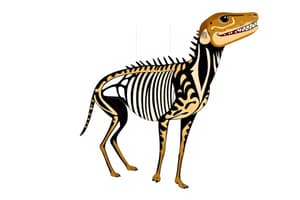Podcast
Questions and Answers
What phylum do vertebrates belong to?
What phylum do vertebrates belong to?
- Reptilia
- Amphibia
- Mammalia
- Chordata (correct)
Which class does not lay eggs and has keratin hair?
Which class does not lay eggs and has keratin hair?
- Amphibia
- Mammalia (correct)
- Aves
- Reptilia
Which class is characterized by having larvae that are aquatic and older individuals having lungs?
Which class is characterized by having larvae that are aquatic and older individuals having lungs?
- Amphibia (correct)
- Mammalia
- Reptilia
- Aves
Which class lays eggs, is cold-blooded, and covered in scales?
Which class lays eggs, is cold-blooded, and covered in scales?
What class is characterized by wings and feathers?
What class is characterized by wings and feathers?
What class does bony fish belong to?
What class does bony fish belong to?
What phylum consists of organisms that filter water through pores?
What phylum consists of organisms that filter water through pores?
Which phylum has stinging cells and is mostly carnivorous?
Which phylum has stinging cells and is mostly carnivorous?
What phylum do flatworms belong to?
What phylum do flatworms belong to?
What class includes snails and slugs?
What class includes snails and slugs?
Which class includes crabs, shrimp, and lobsters?
Which class includes crabs, shrimp, and lobsters?
What class do spiders belong to?
What class do spiders belong to?
What is the defining feature of the phylum Echinodermata?
What is the defining feature of the phylum Echinodermata?
What type of skeleton do Chondrichthyes have?
What type of skeleton do Chondrichthyes have?
Flashcards are hidden until you start studying
Study Notes
Phylum Chordata
- Defined by the presence of a spine or notochord.
Class Mammalia
- Characterized by the presence of hair made of keratin.
- Do not lay eggs.
Class Amphibia
- Life cycle includes larvae that are aquatic with gills.
- Adults possess lungs and glandular skin; semi-terrestrial lifestyle.
- Typically have four legs.
Class Reptilia
- Cold-blooded organisms that lay eggs.
- Have scales; includes species like snakes and alligators.
Class Aves
- Distinguished by wings and feathers.
- All members lay eggs.
Class Osteichthyes
- Known as bony fish; skeleton made of bone.
- Breathe through gills.
Phylum Porifera
- Composed of simple organisms that filter water through pores.
Phylum Cnidaria
- Contains stinging cells; most are carnivorous.
- Life cycle resembles that of plants.
Phylum Platyhelminthes
- Soft-bodied, exhibiting bilateral symmetry.
Phylum Annelida
- Consists of invertebrates with segmented bodies.
- Lack lungs.
Phylum Mollusca
- Exhibit bilateral symmetry; bodies have more than two cell layers.
- Structures lack body cavities.
Class Bivalve (Mollusca)
- Includes clams and oysters; characterized by hinge at the back.
- Size and teeth help determine species.
Class Gastropoda (Mollusca)
- Encompasses snails and slugs.
Class Cephalopoda (Mollusca)
- Known for being predatory with symmetrical bodies and tentacles.
- Commonly found in saltwater; includes octopuses and squids.
Phylum Arthropoda
- Comprises spiders, crabs, lobsters, scorpions, and insects.
- Characterized by segmented bodies with a chitin exoskeleton and jointed legs.
Class Insecta (Arthropoda)
- Three-segment body plan and possesses three pairs of legs.
Class Arachnida (Arthropoda)
- Cold-blooded with eight jointed legs; includes spiders.
Class Crustacea (Arthropoda)
- Comprised of crabs, shrimp, lobsters, and crayfish.
- Features an invertebrate segmented body.
Phylum Echinodermata
- Includes starfish; exhibits radial symmetry.
- Lacks a heart, brain, and eyes.
Class Chilopoda (Arthropoda)
- Characterized by a single pair of elongated legs; resembles insects.
- Commonly known as centipedes.
Class Echinoidea (Echinodermata)
- Features tightly interlocking plate skeleton; includes sand dollars.
Class Asteroidea (Echinodermata)
- Star-shaped body plan centered around a central disk.
Class Holothuroidea (Echinodermata)
- Possesses arms with branched tentacles and is bilaterally symmetrical; commonly known as sea cucumbers.
Class Chondrichthyes
- Known as cartilage fish, including sharks and rays.
Studying That Suits You
Use AI to generate personalized quizzes and flashcards to suit your learning preferences.




